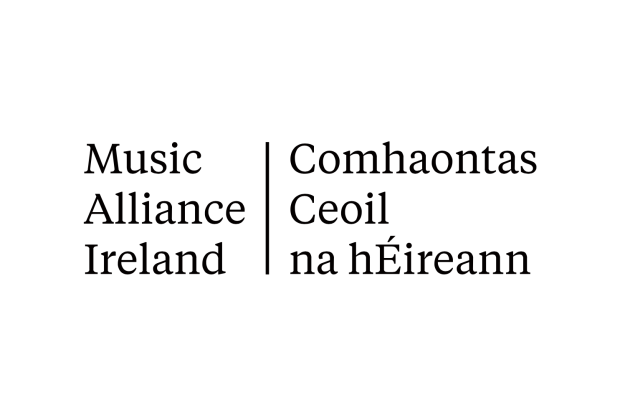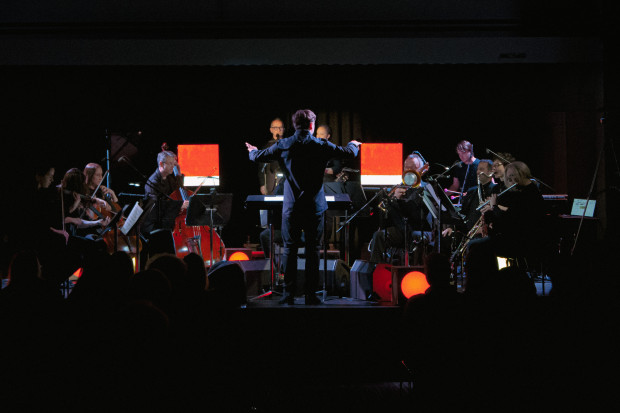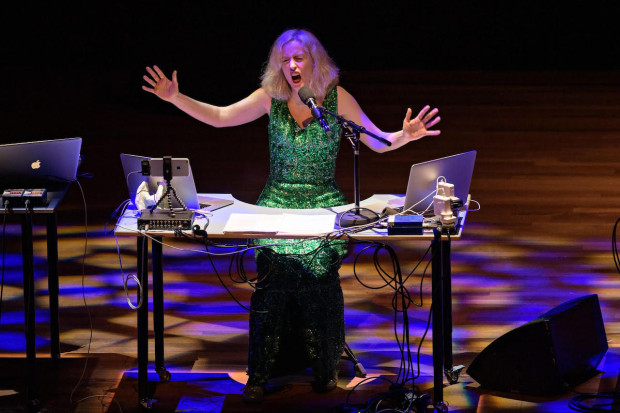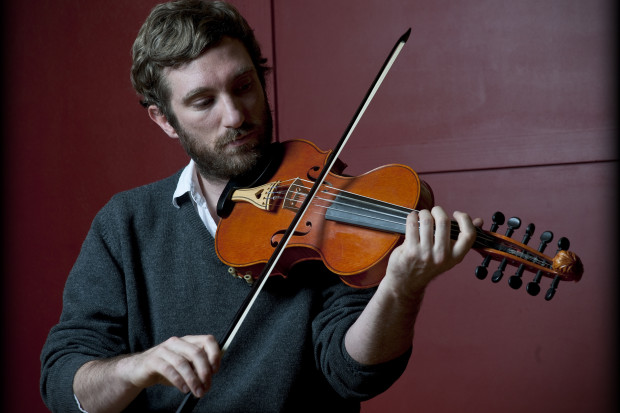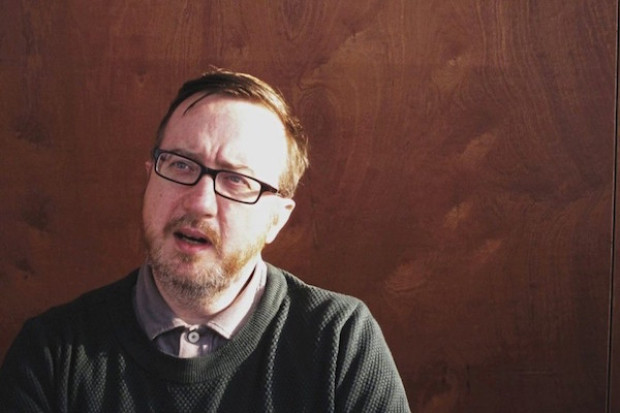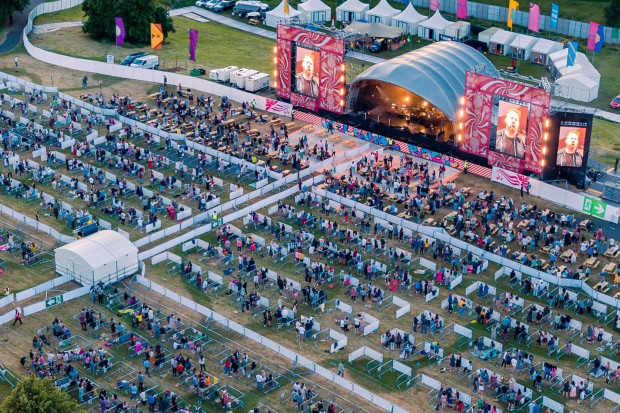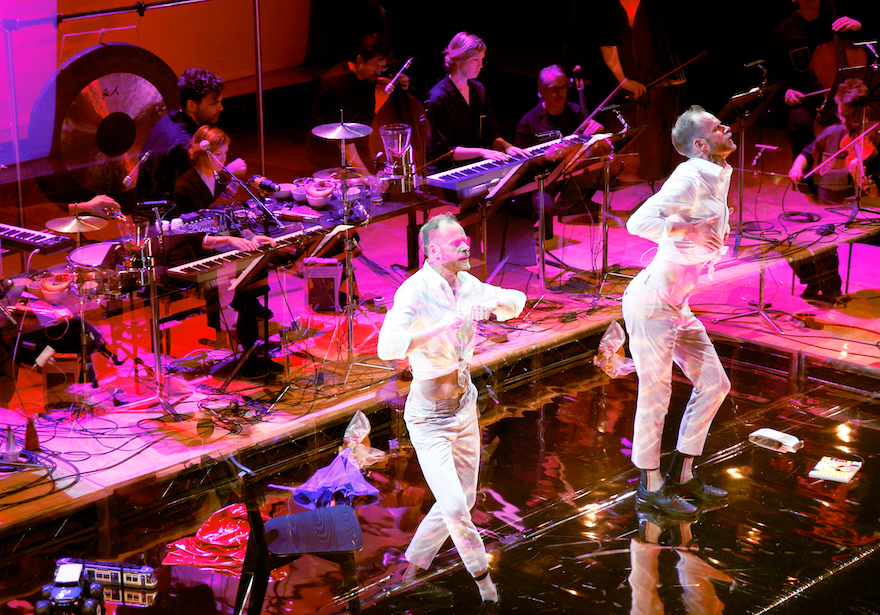
Andreas Borregaard in Jennifer Walshe’s PERSONHOOD at New Music Dublin (Photo: Molly Keane)
An Ambitious and Diverse Return
Even though last year’s online version of New Music Dublin heroically managed to maintain the momentum of the festival in recent years, the overwhelming sense of relief amongst composers, performers and audiences at getting back to live music at this year’s edition was palpable. Sticking to the revamped template of previous years under John Harris – involving the careful intersecting of the stylistic and generational differences of Ireland’s new music scene – this year’s festival featured a total of 25 concerts that included 39 world premieres and 10 Irish premieres, essentially managing to supply a constant stream of live new music from midday until midnight for each day of the expanded four-day festival (28 April–1 May).
The sheer range of concerts meant that it was impossible to cover every event with a level of thoroughness that would do justice to the efforts of the artists themselves. Instead, this article focuses on a selection of concerts that took place on each day of the festival and attempts to give a more detailed account of the works that featured.
A brutal stripping away
Jennifer Walshe’s PERSONHOOD (28 April) set out to explore what it means to be a person in our current world of hyper-stimulation and subservience to a range of invasive digital technologies. Written for the Danish accordionist Andreas Borregaard and the Oslo Sinfonietta, the work treats Borregaard as a kind of guinea pig who is forced to act out a range of bizarre choreographies from ballet pirouettes to press-ups. At the same time, he must navigate enormous quantities of spoken text – assembled, in classic Walshe style, from a concoction of buzz phrases derived from the internet and social media – as well as rearranging everyday objects scattered about the stage and occasionally playing the accordion.
Suffice to say, the piece made enormous demands on Borregaard who fully immersed himself in the role and delivered a performance that stood out as one of the highlights of the festival. For instance, in the section that dealt with the systematic exploitation of a teenage pop-star (clearly Britney Spears), Borregaard tied up his shirt into a crop top and performed a routine that referenced the kind of sexualized physical gyrations typically identified with female pop artists. If this sounds disturbing, that’s because it was and what came across most powerfully was Walshe’s brutal stripping away of the individual’s sense of personal agency, something which cut to the very nature of existence in our technology-saturated world.
Near the end of the piece, the ensemble’s music became lushly polyphonic as the accordionist became the target of the double bass and percussion whose loud, sharp interjections seemed to result in an electric shock being inflicted on him. This was perhaps the one point in the piece where the soloist seemed to momentarily win back some sense of personhood as he tried to withstand the blows and remain upright. However, this was dashed as the next section reverted to catchy dance music and inane lines like, ‘I have my six-pack now, I need to do a sit-up everyday for the rest of my life’. His final task was to compulsively arrange all the objects in a straight line at the front of the stage in a gesture that encapsulated the meaningless of many of our contemporary media-driven obsessions.
Combining elements of music theatre, multimedia, dance choreography and new music, it is impossible to fully describe the multiple layers the piece operated on or pick apart the density of its critique of the impoverished nature of so much contemporary culture. Nevertheless, it certainly demonstrated what Walshe is capable of with performers who are willing to devote themselves fully to the realisation of her vision.
Brittle and complex
The first of the National Symphony Orchestra’s concerts (29 April) was shared with the French new music group Ensemble Interforma, who were performing two Irish premieres of pieces by David Fennessy and the French composer Bastien David, conducted by Stefan Asbury.
David’s L’impatiente for string quartet started off in what seemed like a typical new music opening with an eerie, quivery texture of high register harmonics. However, it very soon marked out a distinctive soundworld all of its own that became particularly fascinating when the players of the quartet started whistling so that one could not really differentiate which pitches were whistled and which were played by the actual instruments. The piece seemed extraordinarily brittle and complex at the same time and received a stunning performance from the players of Ensemble Interforma.
While David managed to generate huge variation within a very confined sound space, the problem with Fennessy’s Panopticon for string sextet and cimbalom was that it simply did not have enough variation. The idea behind the piece was that the cimbalom would act as the ‘leader’ or ‘instigator’, and the notes it played would trigger a ripple effect in the rest of the ensemble. However, the main issue was that the material – pulsing repeated single notes hammered out on the cimbalom that advanced and receded dynamically – were simply not engaging enough to sustain interest over the eighteen-minute duration. In addition, the deliberately muted sound – dampened cimbalom and the string instruments plucked with a plectrum – seemed to constrict the piece and while one could sense Fennessy’s intent to discover new sounds, on this occasion it simply did not come off.
The ‘In Memoriam’ theme came to the fore in the second half of the concert with the performance of Louis Andriessen’s Anachronie I (1966–7) – a composer whose influence on the likes of Donnacha Dennehy and Andrew Hamilton had a huge impact on the Irish new music scene. The piece is an early work of Andriessen’s and its interest lies more in this fact than in the music itself which resembles a postmodern mash-up of a wide variety of styles that stretch from pop songs to 1950s modernism. The same piece had been written far more successfully by others (Alfred Schnittke, Bernd Alois Zimmermann, etc.) and nothing particularly interesting is actually done with the material. Nevertheless, in the crudity of the orchestration, it is possible to hear snippets of what would later become the mature Andriessen signature sound.
As festival director Harris remarked in his introduction to the piece, Benjamin Dwyer’s In Memoriam Maharishi Mahesh Yogi was the only explicitly memorial piece on the programme, being dedicated to the great master of transcendental meditation who has had a profound impact on Dwyer himself. Like a lot of Dwyer’s work, the music was densely woven with intricate separate parts for individual instruments. However, the standout moments were when the frequency of change fell off a little and the composer focused laser-like on a particular sonority. A good example was the end of the opening movement when mildly dissonant chords in the high register of the strings wafted in and out of focus against a repeated rising figure on the piano. The general lack of pulse gave the piece a meditative quality that came to the fore at the finish when the orchestra seemed to inhale and exhale in a series of breathy gestures.
Rebecca Saunders’ trumpet concerto Alba written for Marco Blaauw was one of those pieces where one was simultaneously mesmerised by the astonishing detail of the orchestration but somewhat frustrated by the lack of anything that really stuck in the memory once it was finished. While such pieces might claim to go beyond the conventional parameters of form or melody, the constant search for novel effects in the trumpet part in particular began to wear thin after a while and it was hard not to escape the notion that this was really performers’ music first and foremost.
Natural phenomena and ritual
This Crash Ensemble gig on Saturday evening – the second of three appearances in this year’s festival – featured two world premieres by Emma O’Halloran and Sam Perkin.
O’Halloran’s What I Was Gonna Say opened with a series of catchy resonant chords that formed the basis for much of the piece over which other material was progressively layered. Although repetitive, the piece possessed quite a bit of variation; the layering of a cimbalom-like riff from a synthesiser stood out in particular as the mood became more boisterous with contributions from the trombone and bass drum. The opening chordal riff gradually panned out into longer durations before transitioning into a darker, more dissonant section that suddenly broke off into a breathy texture of flute and clarinet with string-crossing harmonics on the violin and viola. Further variations over altered versions of these chords constituted the rest of the piece and it ended with a coda that reprised the opening, now movingly recast in a more ambient mood. The piece had many sections of memorable material but it did possibly seem like an accompaniment to something bigger and, at twenty minutes in length, had well exhausted the material by the finish.
Perkin’s Children in the Universe seemed to mark the culmination of a direction that he has been pursuing over the past few years in works like Visualization and Alta, a direction defined by an ethereal soundworld of shimmering halos (a mirroring of the live element) and a fascination with natural phenomena and ritual. Described by the composer as a ‘Hybrid Symphony for the Crash Ensemble and Halo Track’, the piece began in quite typical Perkin style with a series of such ‘halos’ – big widely spaced cosmic chords that advance and recede, impressively exploiting the blending of electronic and live elements. At a certain point, the soloist or ‘guide’ – violinist Diamanda La Berge Dramm – approached the stage wearing a wolf headdress and started to intone wolf howls that mixed with other nature sounds on the electronic part. Quite unexpectedly, this ethereal atmosphere broke off into an entirely different section that began with a simple computer-game-sounding synth riff that then transitioned impressively into a heavier pulsing section overlaid with a series of flurries from the players that culminated in a ritualistic upward gesture. The highlight of the piece was perhaps the final section where a series of slow sliding melodies and frantic fast figurations divided across the ensemble generating a texture of incredible richness that sat somewhere between Sibelius and Sigur Rós. While the ritualistic gestures came across as a little kitschy and the whole ‘halo’ fascination may be starting to exhaust itself in Perkin’s music generally, there was no doubting the assured craftsmanship of the work and it clearly made a big impression on the audience.
Otherworldly vocals
Over the last few festivals the Diatribe label has carved out a niche for itself as the late night purveyor of cutting edge jazz and experimental music. This year was no different and this Saturday night concert (30 April) featured the launch of three albums from some of Ireland’s most creative improvising acts.
Roamer are a quartet of vocalist Lauren Kinsella, tenor saxophonist Sam Comerford, electric bassist Ruth Goller and Matthew Jacobson on drums. The most instantly striking feature of their music is Kinsella’s vocal style which periodically veers off into extended techniques that sound otherworldly. Her duets with Comerford’s beautifully melodic saxophone playing that jumped between unison and heterophony were particularly impressive. While much of the initial focus was on this chemistry between Kinsella and Comerford, as the set progressed, one gradually realised that the group’s distinctive sound had as much to do Goller’s robust electric bass sound – the tone of Nirvana’s Krist Novoselic mixed with the dexterity of Jaco Pastorius – and the interaction of her grooves with the superb Matthew Jacobson on drums.
Shane Latimer’s set involved the interaction between his extended electric guitar and a complicated assemblage of electronic equipment. His set began without any ceremony and for a few moments one was not entirely sure if the performance had actually started or whether he was dealing with a technical malfunction involving faulty leads. From this stuttering opening of pops and crackles, the ensuing improvisation traversed an extraordinary range of textures and the whole performance was visually compelling as Latimer manipulated the jumble of boxes and leads – as well as his guitar – in a fascinating meeting of man and technology.
During the final stages of Latimer’s performance the volume did rise to a level that felt uncomfortable for many in the front rows. However, the volume of the third act – the quartet BigSpoon who were launching their album Return of the Prodigal Son – was, from the outset, way over the top to the point of being irresponsible. I started to physically feel pain in my ears and had to leave shortly into the performance. Several others followed suit. While the band’s blistering opening sounded promising, the unnecessary volume came across as rather juvenile and no audience should be exposed to that level of discomfort.
Understated concentration
The RTÉ Concert Orchestra’s contribution to the festival (1 May) featured three world premieres and one Irish premiere in a concert entitled ‘Deliverance’ conducted by Gavin Moloney. The concert featured a solo piano piece by Garrett Sholdice and a piano concerto by Andrew Synnott featuring pianist Michael McHale plus two orchestral pieces by Ailís Ní Ríain and Stephen Gardner. All four works were born in lockdown which formed the linking thread that connected these rather different pieces together.
In his Prelude No. 12, Sholdice set himself the difficult task of writing a single melodic line that would extend – without accompaniment or added lines – for the entire duration of the piece. The deceptive transparency of Sholdice’s work often hides the secure sense of structure and timing that lies beneath the surface. Calculated repetitions and the intermittent insertion of gentle rhythmic hiccups between the crotchet pulse meant that the line maintained its tension right through until the end of the piece.
This performance demanded a level of understated concentration from McHale who then seemed to relish the opportunity to plunge into Synnott’s concerto Waiting for Elvira, a work written as a partner piece to Mozart’s piano concerto No. 21 in C, widely known as the ‘Elvira Madigan’. The concerto was a well-crafted piece of neo-classical pastiche that dispensed with any notion of originality right from the opening bars. Nevertheless, it did have sections of catchy material with the bouncy melodies in the two A sections and the oboe melody in the B section of its ternary structure being particularly pleasant. The nod to the famous opening melody of the slow movement of Mozart’s concerto pulverised by an orchestral tutti at the end was quite amusing.
Ní Ríain’s Flower Scar Road was, amazingly, the first orchestral piece by this established composer and playwright. The piece opened with a series of short, dissonant gestures punched out as an orchestral tutti separated by uneven silences. As these gradually merged into each other, the texture became increasingly frenetic and at one stage threatened to blend into a marching band type texture. A second calmer section ensued but the rhythmic syncopations and constant forceful interjections from the woodwind and brass meant that the piece retained its edginess to the finish even if the actual material itself was not particularly distinctive.
Having provided the thematic idea for the concert programme it was fitting that Gardner’s Deliverance was the main focus of the concert. Based on the notion of being delivered from the stasis and restrictions of the pandemic, the composer wrote that he wanted to make the piece ‘energetic and positive’ and it certainly gave the players of the orchestra a good work out. Despite all the piece’s busyness, however, much of the material came off as quite undifferentiated. Large swathes of it consisted of jagged, angular lines for individual instruments that rippled over each other tumultuously. While there were some interesting ideas such as a recurring sustained static chord on strings that formed the backdrop for some nice lines on the brass and woodwind instruments, particularly the oboe, the orchestra was generally treated more like an ensemble of individual instruments and there was very little attempt at blending or searching for distinctive sonorities. Also, the lack of timing or sense of arrival over the course of its twenty-five minute duration meant that it made for a tough listen.
Melting into a shimmering coda
One of the main featured artists of the festival was Dutch violinist La Berge Dramm who – aside from taking the solo part in Perkin’s Children in the Universe – was the focus of two events that coincided with the launch of her album Chimp on Diatribe Records. The first event on Friday night (29 April) saw her performing on the Diatribe stage with saxophonist Nick Roth and the poet Steven J. Fowler, whose texts supplied the lyrics for the album. For the second event (1 May), she performed songs from the album in ‘reimagined’ arrangements for the Crash Ensemble conceived by both herself and the star of last year’s New Music Dublin – Barry O’Halpin.
For this concert the songs were played in the same order that they appear on the album where they blend into each other in the manner of a concept album. The runaway hit was the opening song ‘born’, which stands out for its haunting melody that rises in peaks and troughs to a point of moving vulnerability in the higher part of La Berge Dramm’s vocal range. Reflecting its powerful appeal, the same melody is reprised for the closing song ‘memory’, which appeared in this concert in a beautiful arrangement by O’Halpin that melted into a shimmering coda of harmonic glissandos on violin and viola and resonant sonorities on the piano and percussion. The concert was greatly enhanced by video imagery by Laura Sheeran presented on screens around the ensemble that perfectly blended with the atmosphere of La Berge Dramm’s music.
Developments, focus and audiences
Without having attended every concert, it was difficult to say how this festival compared to its previous incarnations. Some of the concerts I missed – such as Isabelle O’Connell’s piano recital and Colm O’Hara’s 10tet improvising music ensemble – certainly impressed judging by the word on the street. The festival did not seem to lack any of the ambition of past editions and, if anything, the expanded format and the forays into new areas – which included a concert for (very) young composers and a work with sign language by George Higgs – seemed to continue the festival’s innovative character and maintain the momentum built up over the last four festivals. It was encouraging to see the successful relationship fostered with the likes of the NSO, RTÉ Concert Orchestra, Cór na nÓg and Cór Linn, Crash Ensemble, Hard Rain SoloistEnsemble and others continue to develop and evolve. Another encouraging development was that the festival has continued to become a favoured platform for album launches by Ireland’s experimental record labels (Diatribe and Ergodos) – who both had a number of dedicated concerts – and whose work forms a crucial component of the Irish new music infrastructure. This year the Irish Composers’ Collective also released an eclectic album that will give listeners a broad sample of the work of emerging composers.
In the midst of this diversity, I did wonder if perhaps the festival needed a more central focus – a featured composer or some sort of main theme – but then again, this was the undoing of previous festivals as the question of who to pick or what to focus on tended to be divisive. Audience attendances seemed broadly in line with previous years although anything that took place in the main hall of the NCH looked quite sparse. Some events such as the Crash Ensemble gigs and Jennifer Walshe’s PERSONHOOD would perhaps work better in more informal venues. The latter, in particular, seemed out of place in the inescapably formal surroundings of the NCH main stage. Overall, Irish audiences have remained true to form (if not tribal) in following their favourite groups and display a marked reluctance to step out of their respective comfort zones.
However, these points aside, I certainly came away with the impression that New Music Dublin is in good health and looks set to continue to prosper as Ireland’s premier new music festival in the years to come.
Visit www.newmusicdublin.ie.
Published on 5 May 2022
Adrian Smith is Lecturer in Musicology at TU Dublin Conservatoire.












